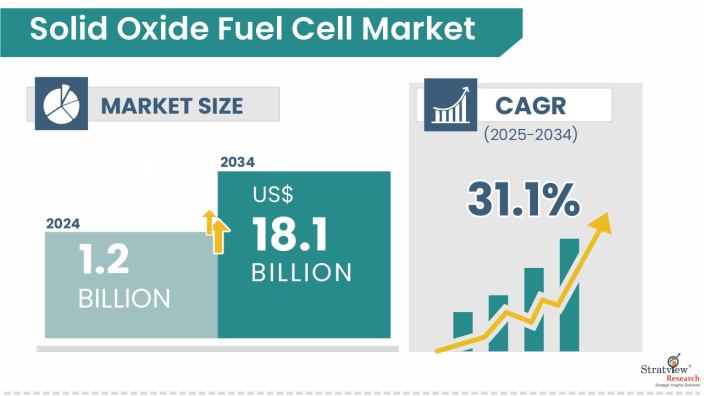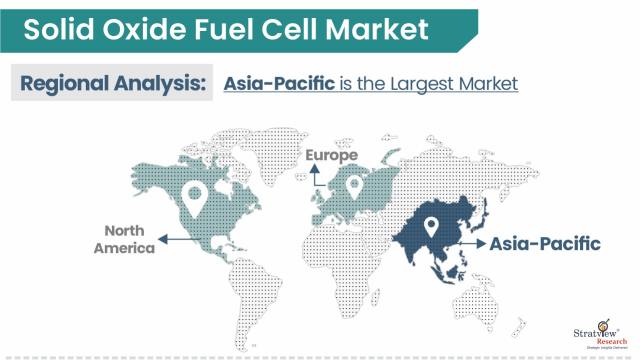Market Insights
The solid oxide fuel cell market was estimated at USD 1.2 billion in 2024 and is likely to grow at a robust CAGR of 31.1% during 2025-2034 to reach USD 18.1 billion in 2034.

Want to know more about the market scope? Register Here
Market Dynamics
Introduction
A solid oxide fuel cell (SOFC) is a type of electrochemical conversion device that produces electricity directly from oxidizing a fuel. It operates at high temperatures (typically between 600°C and 1,000°C) and uses a solid oxide or ceramic as the electrolyte. Unlike other types of fuel cells, SOFCs can run on a variety of fuels, including hydrogen, natural gas, and biogas, offering flexibility and high efficiency.
The SOFC market is gaining attention due to increasing demand for clean and efficient energy solutions across residential, commercial, and industrial sectors. The technology is particularly valued for its low emissions, fuel flexibility, and long-term stability. Governments, industries, and energy providers are investing in SOFC systems for backup power, distributed generation, and as part of hybrid energy systems, thus contributing to the market’s growth.
As the global push towards sustainable energy intensifies, the SOFC market is expected to expand significantly, driven by innovations in materials, cost reduction strategies, and supportive policy frameworks.
Recent Market JVs and Acquisitions:
Recent trends in the solid oxide fuel cell (SOFC) market indicate a significant increase in joint ventures and acquisitions, driven by the pursuit of technological advancement, market expansion, and alignment with global decarbonization goals. Companies are forming strategic partnerships to combine expertise in materials science, manufacturing, and system integration, facilitating faster commercialization of SOFC technologies. These collaborations often involve shared research & development efforts, leading to cost reductions and improved product performance. Additionally, mergers and acquisitions are being utilized to consolidate market positions, acquire complementary technologies, and enter new geographic markets. This dynamic landscape reflects a concerted effort within the industry to accelerate the deployment of SOFC systems across various applications, including residential, industrial, and transportation industries.
A considerable number of strategic alliances, including M&As, JVs, etc., have been performed over the past few years:
- In August 2024, HD KSOE invested approximately $80 million to acquire a majority stake in Finland-based Convion, a company specializing in SOFC and SOEC technologies.
- In January 2020, SK Engineering & Construction (SK E&C) established a joint venture with U.S.-based Bloom Energy to produce solid oxide fuel cells in South Korea. The joint venture, Bloom SK Fuel Cell, aims to annually produce 50 megawatts of SOFCs, with plans to expand production capacity in the future.
Segment Analysis
|
Segmentations
|
List of Sub-Segments
|
Segments with High-Growth Opportunity
|
|
Component-Type Analysis
|
Stack and BOP
|
Stack is expected to continue its dominance during the forecast period due to their central role in energy generation, coupled with ongoing advancements in materials and manufacturing processes.
|
|
Application-Type Analysis
|
Stationary, Portable, and Transport
|
Stationery is anticipated to both dominate & exhibit the highest growth rate throughout the forecast period.
|
|
End-User Type Analysis
|
Commercial & Industrial, Data Centers, Military & Defense, and Residential
|
Commercial & Industrial is expected to dominate the market during the forecast period due to the increasing demand for reliable, efficient, and environmentally friendly power solutions in commercial and industrial applications.
|
|
Regional Analysis
|
North America, Europe, Asia-Pacific, and The Rest of the World
|
Asia-Pacific is expected to dominate the market throughout the forecast period.
|
By Component Type
“The stack segment is expected to continue to dominate the market during the forecast period.”
Based on the component, the market is segmented into the stack and BOP. Stacks are expected to continue dominating the market because stacks are the core units where electrochemical reactions occur, directly converting fuel into electricity. Their central role in energy generation, coupled with ongoing advancements in materials and manufacturing processes, has solidified their leading position in the market. Conversely, the Balance of Plant (BOP) segment, which includes auxiliary components like heat exchangers, pumps, and control systems, is projected to experience the highest CAGR during the forecast period. This growth is driven by the increasing demand for integrated and efficient SOFC systems, where optimized BOP components are essential for overall system performance and cost-effectiveness.
By Application Type
“The stationary category is anticipated to dominate the market as well as exhibit the highest growth rate throughout the forecast period.”
Based on the application, the market is segmented into stationary, portable, and transport. Among these, stationary is expected to both dominate and exhibit the highest growth rate during the forecast period. The dominance is attributed to the increasing demand for efficient and reliable power generation solutions in residential, commercial, and industrial settings. In addition to these, the factors contributing to this rapid growth include increasing government investments in renewable power generation, technological advancements, and the rising need for decentralized power generation and grid independence.
By End-User Type
“The commercial and industrial segment is expected to dominate throughout the forecast period.”
Based on the end-user type, the market is segmented into commercial & industrial, data centers, military & defense, and residential. Among these, the commercial & industrial is expected to dominate the market throughout the forecast period. This dominance is attributed to the increasing demand for reliable, efficient, and environmentally friendly power solutions in commercial and industrial applications. SOFCs offer high efficiency and flexibility, making them ideal for large-scale energy needs such as powering manufacturing plants, office complexes, and industrial facilities. Meanwhile, the data centers segment is expected to experience the highest CAGR throughout the forecast period. This rapid growth is driven by the escalating demand for digital services and cloud computing, leading to an increased strain on power infrastructure.
Regional Insights
“The Asia-Pacific region is expected to dominate the market during the forecast period.”
Asia-Pacific is expected to dominate the solid oxide fuel cell market in terms of market size throughout the forecast period due to strong government support, significant investments in clean energy technologies, and the widespread adoption of SOFCs in stationary applications across countries like Japan, South Korea, China, and India.
Europe is anticipated to experience the highest CAGR in the SOFC market. This rapid growth is driven by aggressive climate action policies, substantial investments in clean energy technologies, and a strong emphasis on reducing carbon emissions.

Know the high-growth countries in this report. Register Here
Key Players
The market consists of a considerable number of players, featuring several key players renowned for their expertise and contributions. The following are the key players in the solid oxide fuel cell market.
Here is the list of the Top Players (Based on Dominance)
- Bloom Energy
- Siemens Energy
- Mitsubishi Heavy Industries
- Ceres Power
- Aisin Corporation
- FuelCell Energy
- Sunfire GmbH
- Elcogen
- Convion
- Doosan Fuel Cell
Note: The above list does not necessarily include all the top players in the market.
Are you the leading player in this market? We would love to include your name. Please write to us at [email protected]
Report Features
This report provides market intelligence most comprehensively. The report structure has been kept so that it offers maximum business value. It provides critical insights into market dynamics and will enable strategic decision-making for existing market players as well as those willing to enter the market. The following are the key features of the report:
- Market structure: Overview, industry life cycle analysis, supply chain analysis.
- Market environment analysis: Growth drivers and constraints, Porter’s five forces analysis, SWOT analysis.
- Market trend and forecast analysis.
- Market segment trend and forecast.
- Competitive landscape and dynamics: Market share, Service portfolio, New Product Launches, etc.
- COVID-19 impact and its recovery curve
- Attractive market segments and associated growth opportunities.
- Emerging trends.
- Strategic growth opportunities for the existing and new players.
- Key success factors
Market Segmentation
This report studies the market, covering a period of 12 years of trends and forecasts. The report provides detailed insights into the market dynamics to enable informed business decision-making and growth strategy formulation based on the opportunities present in the market.
The global solid oxide fuel cell market is segmented into the following categories.
By Component Type
- Stack (Regional Analysis: North America, Europe, Asia-Pacific, and Rest of the World)
- BOP (Regional Analysis: North America, Europe, Asia-Pacific, and Rest of the World)
By Application Type
- Stationary (Regional Analysis: North America, Europe, Asia-Pacific, and Rest of the World)
- Portable (Regional Analysis: North America, Europe, Asia-Pacific, and Rest of the World)
- Transport (Regional Analysis: North America, Europe, Asia-Pacific, and Rest of the World)
By End-User Type
- Commercial & Industrial (Regional Analysis: North America, Europe, Asia-Pacific, and Rest of the World)
- Data Centers (Regional Analysis: North America, Europe, Asia-Pacific, and Rest of the World)
- Military & Defense (Regional Analysis: North America, Europe, Asia-Pacific, and Rest of the World)
- Residential (Regional Analysis: North America, Europe, Asia-Pacific, and Rest of the World)
By Region
- North America (Country Analysis: The USA, Canada, and Mexico)
- Europe (Country Analysis: Germany, France, The UK, Russia, and the Rest of Europe)
- Asia-Pacific (Country Analysis: Japan, China, India, and Rest of Asia-Pacific)
- Rest of the World (Country Analysis: Brazil, Saudi Arabia, and Others)
Research Methodology
- This strategic assessment report from Stratview Research provides a comprehensive analysis that reflects today’s solid oxide fuel cell market realities and future market possibilities for the forecast period.
- The report segments and analyzes the market in the most detailed manner in order to provide a panoramic view of the market.
- The vital data/information provided in the report can play a crucial role for market participants and investors in identifying the low-hanging fruit available in the market and formulating growth strategies to expedite their growth process.
- This report offers high-quality insights and is the outcome of a detailed research methodology comprising extensive secondary research, rigorous primary interviews with industry stakeholders, and validation and triangulation with Stratview Research’s internal database and statistical tools.
- More than 1,000 authenticated secondary sources, such as company annual reports, fact books, press releases, journals, investor presentations, white papers, patents, and articles, have been leveraged to gather the data.
- We conducted more than 15 detailed primary interviews with market players across the value chain in all four regions and industry experts to obtain both qualitative and quantitative insights.
Customization Options
With this detailed report, Stratview Research offers one of the following free customization options to our respected clients:
Company Profiling
- Detailed profiling of additional market players (up to three players)
- SWOT analysis of key players (up to three players)
Competitive Benchmarking
- Benchmarking of key players on the following parameters: Service portfolio, geographical reach, regional presence, and strategic alliances
Custom Research: Stratview Research offers custom research services across sectors. In case of any custom research requirement related to market assessment, competitive benchmarking, sourcing and procurement, target screening, and others, please send your inquiry to [email protected]

